Home / Visitors / Visitor Attractions / Shadows of the Past
Shadows of the Past
Folklore & History of the Heritage Highway
Two hundred years on there’s still plenty of ways to get held up on the Heritage Highway.
Keep an eye out between Tunbridge and Kempton for sixteen silhouettes. Some are quite close to the road; some are high on the hilltops. What stories can they tell us about the history of this intriguing region?
Take a tour through the Heritage Highway Silhouette Trail
Click an icon below to view information about each Silhouette
The Artists
Shadows of the Past is a project initiated by local artists, Folko Kooper and Maureen Craig, that puts a contemporary slant on the eighteenth century art form of the silhouette, creating poignant reminders of early colonial life on the Heritage Highway.
The Research
This material is drawn from records kept meticulously by the colonial authorities. There is no such comprehensive record of Aboriginal voices of the time. We can try to imagine the Aboriginal peoples’ experiences. It is likely they would tell a very different story of these events.
Shadows of Past Map
Emus, south of Tunbridge
Tasty, flightless and far too curious for its own good!
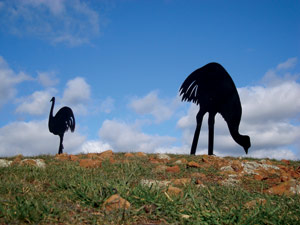
Did you know that a Tasmanian species of emu ran wild across the island until the mid-1800s? It was smaller than its larger mainland relative, but probably just as inquisitive. Aboriginal women gathered emu eggs. Aboriginal men trapped and hunted these flightless birds with spears. They probably also tricked the nosy creatures with bunches of feathers tied onto sticks. Once close enough to a concealed hunter, a noose was slipped around the emu’s neck. One emu made a good-sized meal.
Early settlers, too, feasted on the bird - so much so that the Tasmanian emu has been eaten into extinction.
The Tasmanian emu is extinct. Exactly when this happened we can not say for sure because its larger mainland cousin was introduced onto the island by early European settlers. Suffice to say, neither creature grazes free on the Tasmanian grasslands today.
Tasmanian emus thrived in the open ‘park land’ of the Midlands. Fleet of foot, they could outrun most predators. However, the emu was also a curious bird, and what they say about the cat could also apply here. Like Aboriginal hunters on the Australian mainland who lure emus with feathers
tied to the ends of sticks, Tasmanian Aborigines probably employed similar subterfuge. Once the birds are within range of the hidden hunter they can be caught in a noose. Tasmanian Aborigines certainly used decoys to catch ducks. Whether traps, spear hunting skills or trickery were used, there is certainly evidence of both the bird and its eggs being eaten. Aboriginal men undertook the hunting and women collected the eggs.
Early European settlers in Van Diemen’s Land enjoyed the bounty that this island had to offer. Emu, kangaroo and wild duck were easy prey to a hunter with his efficient killer companion – the hunting dog. Twenty years of intense hunting meant that by the 1830s the ‘empty lands’ of the north-east, where Aboriginal peoples had retreated, were the only area in which Tasmanian emus still grazed. As the incoming ‘settlers’ exploited this land intensively it was not long before there were only a few emus left.
By the middle of the 1800s, the few known Tasmanian emus were in captivity. Two roamed in the grounds of Mona Vale, William Kermode’s estate in the Midlands near Ross. It is recorded that Mr Dyer, an unfortunate guest from Hobart Town, was knocked to the ground and trampled on by one of these strange and curious creatures. His embarrassed host rushed to his rescue.
As an old man Mr Ransom of Killymoon in the Fingal district of northern Tasmania, recalled hunting Tasmanian emus around 1840 when he was eighteen. He remembered some Tasmanian emu eggs being taken and successfully bred using a turkey hen as surrogate mother. However, when birds from this breeding program drowned trying to cross a flooded river in 1873, the last known example of the species was gone.
Ask most Tasmanians and you will find that they never knew the Tasmanian emu ever existed. The only remaining complete specimens can be found at the British Natural History Museum in London.
The troop of soldiers, St. Peters Pass
Soldiers, soldiers everywhere!
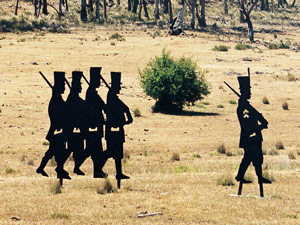
Van Diemen’s Land was first and foremost a British military outpost. Soldiers accompanied the convicts on the transport ships, supervised the rationing of supplies, and guarded the chain gangs – as well as watching out for the French! Most didn’t stay long. There were other British interests around the world to defend. Many of the convicts they guarded had also been soldiers, but were reduced to committing crime once the wars they were fighting ended and they were out of a job.
By the beginning of the 1820s, most of the suitable farming land around the main centres in the north (Launceston) and the south (Hobart Town) had been ‘settled’. The land in between was to become highly sought after as colonial policy changed: a ‘landed gentry’ began to build estates on the Aboriginal lands in the Midlands plains. How did this come about?
In 1821 Commissioner John Bigge came on an inspection tour of the island on behalf of the British Government. He recommended that the Crown introduce a deliberate policy to create an upper class of wealthy landowners who would be empowered to maintain order. The ensuing land grant system granted suitable farming land, and assigned convict servants, to free men in proportion to their assets. This would fuel further growth in the European population of the Midlands.
In that year Governor Macquarie considered that a military outpost was needed to protect the growing number of European settlers from bushrangers, and from the Aboriginal peoples who were protesting their presence. There was concern for the road through the Midlands plains, which was becoming an important colonial transport artery; its security was considered central to the economy of the colony.
After 1825, when Van Diemen’s Land became a colony in its own right, Lieutenant-Governor Arthur set about establishing the military outpost of Oatlands. Soldiers were initially involved in supervising the building of roads and other infrastructure until the Field Police was established by Arthur in 1827. The military was also engaged in organising the most significant campaign of the time, the infamous ‘Black Line’.
During the 1820s, confrontation between settlers and Aboriginal people increased. European encroachment was extending across the open central plains that centuries of careful land management by Aboriginal people had created. The Aboriginal peoples were engaged in a guerrilla campaign to protect their land and resources, and to survive in their homelands. In 1828 Arthur declared martial law and banned Aboriginal people from entering the ‘settled areas.’ In 1830 he instigated the ‘Black Line’, with the aim of forcing the remaining Aboriginal people onto the Tasman Peninsula where he believed they could be readily contained.
Over 500 soldiers and at least 2000 field police and other civilians were involved in the campaign. This required an extraordinary level of planning and resources. Oatlands, the central outpost in the Midlands, was established as the major distribution centre where soldiers and civilians could be assembled and stores of food accumulated and distributed. The Line stretched across the parts of the island that had been ‘settled’ by Europeans between Lake Sorell in the Central Highlands and Campbell Town in the Midlands. It moved southeastwards ostensibly pushing the remaining Aboriginal peoples before it. On the surface the campaign was not successful – only a young boy and an old man were reported as being taken, and two Aboriginal people are reported to have been killed. However, the campaign revealed to the Aboriginal people the force of arms that could be brought against them if they tried to remain on their homelands.
The chain gang, North of York Plains turnoff
A desperate lot!
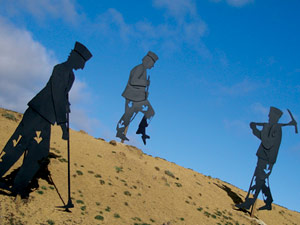
There was a lot to do to build the colony of Van Diemen’s Land. Convicts with skills were in high demand and were often assigned to wealthy landowners and treated quite well. Convicts without special skills were relegated to road gangs. Doing time with the notorious chain gang was not a normal experience for convicts. The chain gang was an 1826 colonial innovation designed to break the spirit of those who were insolent or questioned authority. Men were made to break rocks and dig ditches with their ankles chained together. The greater the punishment, the shorter was the chain. The pain was excruciating. The threat of the chain gang helped to keep the convicts in line.
In the penal settlement of Van Diemen’s Land, the reality for most convicts did not conform to today’s stereotyped images of men in broad-arrow stamped clothes, dragging a ball and chain, working on road gangs and receiving lashes. Whilst this was the experience of some, the overwhelming majority of convicts were assigned to work for landowners who had been granted land across the island. The arrows on clothes simply meant government-issue. Their rations were generous and many married or settled down and raised families. There were no bars on their windows; they lived in cottages, not cells.
The colonial labour market was reliant on the skills of the convicts. Carpenters, masons, bricklayers, mechanics, blacksmiths, sawyers, wheelwrights and coopers were particularly valued. Their masters’ reliance on their practical abilities gave skilled convicts more power in the bargain for indulgences. Minor transgressions, such as drunkenness, were often tolerated for fear that the magistrate would reassign the accused convict to another property.
Convicts with no skills were relegated to the work gangs, building the roads and bridges that connected the settlements that were being established across the island.
Where the stereotypical image of the convict did hold true was on the chain gang. The penal system in the early 1820s was based on the belief that harsh punishment was the key to reforming the criminal classes. In 1826, under Lieutenant-Governor Arthur’s authority, the chain gang was trialed as a punishment. It was invented especially for convicts and men with tickets-of-leave who dared to be insolent or question authority. The method was found to be effective in curbing recalcitrant behaviour and became an integral part of the punishment system. Soldiers, rather than convict overseers, guarded the men on the chain gangs. ‘Never were men better worked, better flogged and better managed that they were in the gang’.
The bushranger, south of Oatlands
The price of freedom!
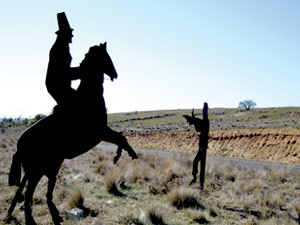
A number of convicts chose to be bushrangers because it was better than the chain gang and the land provided them with food and shelter and a sense of freedom - but freedom was often short lived. Convicts took advantage of the rewards and pardons offered for hunting down bushrangers. By capturing or killing bushrangers, convicts could gain their own ticket to freedom.
Relatively few convicts were under constant lock and key in Van Diemen’s Land, and some were given guns and dogs to hunt kangaroo and emu for their masters. Rather than suffer the hard life and contend with the authority of their masters, some convicts preferred to go it alone, living on their wits and what they could gather from the land, learning from the Aborigines or stealing from the settlers. Those who did best formed alliances with local Aboriginal people and indeed with European settlers who turned a blind eye to their illegal activities.
It was not the deliberate violence that bushrangers craved but independence. The same went for those convicts who informed on bushrangers or were instrumental in their capture. Bushranging and bounty hunting came from the same source – the desire for personal freedom.
Richard Lemon formed the first organized gang of bushrangers in 1805. By the second decade of settlement, however, bushrangers had virtually taken over the interior of the island. This prompted Lieutenant-Governor Davey to declare martial law in 1815. Not that this was successful. For example, the Midlands remained the haunt of such notorious bushrangers as Michael Howe (killed in 1818) and Matthew Brady (captured and hanged in 1826).
Michael Howe, referred to as ‘Governor of the Woods’, virtually held the settlers of the Midlands to ransom. He gained his power through his alliances with some wealthy and influential landowners and with local Aboriginal people through his partner who was known to the settlers as ‘Mary Cockerill’ or ‘Black Mary’. He embodied the myth that there was a life of freedom to be had in the bush of Van Diemen’s Land and was a hero to convicts and ticket-of-leavers who could imagine a better life. Howe’s life ended inevitably and violently at the hands of two convict bounty hunters assisted by Private William Pugh of the 48th Regiment.
Bushranging was not curbed until the late 1840s, with Martin Cash, Lawrence Kavanagh and George Jones among the last of their kind. Interestingly, Cash returned to Van Diemen’s Land after a period on Norfolk Island and became a police constable. He was one of the few bushranger who lived to a ripe old age.
The gentleman in a gig, south of Oatlands
A new England!
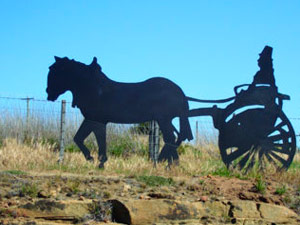
Who am I? If this was 1821 I could be doctor William Redfern, who accompanied Governor Lachlan Macquarie on his final tour of Van Diemen’s Land when he decided the location of many of the towns along this Highway. Ten years later and I might be landowner and Police Magistrate Thomas Anstey going to decide the fate of accused wrongdoers at the beautiful new courthouse in Oatlands. If it was 1852 then I could be Anstey’s son, Henry, heading to Oatlands’ newly built Catholic Church, having made a substantial donation to its construction fund. It was designed by Pugin, the famous architect of the interior of the Houses of Parliament in London.
The Governor’s Doctor: When Governor Lachlan Macquarie made his tour of duty of Van Diemen’s Land in 1821 he brought his wife and their family doctor. The couple travelled the length of the island in their carriage while former-convict Dr William Redfern accompanied them in a gig. Life as a colonial doctor was varied and often demanding, inevitably involving travel. This trip occurred at a turning point in the colony’s history.
Commissioner John Thomas Bigge had come from Britain on an inspection tour of the colony, arriving in Sydney in 1819. Concerned to ensure the convicts of Van Diemen’s Land did not fare as well as they were in New South Wales, he recommended the introduction of a land grant system which would encourage the ’right’ class of people to come to the colony and rewarded those already within it. This class could then take up positions of authority. Given the lack of an inherited aristocracy, an upper class in Van Diemen’s Land was to be an almost instant creation.
Professional and middle class immigrants were given land and convict labour in proportion to their wealth. In a very short period, ending in 1831, most of the remaining productive land on the island was divided into grants and the grand houses that are scattered across the island were built. The landowners often became officials and magistrates, giving them ultimate control over the lives of both free settlers and convicts.
The Police Magistrate: Thomas Anstey was eligible for a land grant. He chose land near Oatlands and within a very short time was given the role of Police Magistrate. This was an extremely powerful position. He could decide the fate of those, both convict and free. It was Anstey who recommended, and then oversaw the work of, the ‘roving parties’ which sought to remove Aboriginal people from the ‘settled’ districts. Anstey also presided over those who came before the court accused of anything from violence and stealing to drunkenness and insolence. Landowners were keen to retain those convicts with useful skills such as blacksmiths, bricklayers, and carpenters. However if these convict workers were unhappy with their masters they could work the system so they might be transferred. Skilled workers could more or less hold the landowners to ransom. Landowners were beholden to the magistrate too, as one of the punishments available to him was to remove assigned servants from a particular master. Anstey determined to whom were assigned the best convict workers.
Off to Church: In the 1800s, the vast majority the immigrant population went to church. Churches of most major Christian denominations had been built in Oatlands by the middle of the century. Perhaps the most famous today is St Paul’s Catholic Church. This church and St Patrick’s in Colebrook were designed by Augustus Pugin, the designer of the Gothic interior of the Westminster House of Parliament in London. Pugin did not come to Tasmania, instead his friend Bishop Willson brought with him fine detailed models of the designs when he came from England to take up his position as the island colony’s first Catholic Bishop in 1844.
The shared vision of Bishop Willson and of Augustus Pugin was to make the new diocese of Van Diemen’s Land a Gothic Jerusalem through architecture, decoration and furnishing, which would reflect the grandeur of medieval religious faith, devotion and liturgy.
Layer 3
William Redfern
William Redfern, personal doctor to Governor Lachlan Macquarie and his family, was probably born in Canada around 1774. He trained as a surgeon in England before plying his trade at sea working as a surgeon’s mate in the navy.
While at sea, Redfern had the misfortune of being caught up in a mutiny. This saw him hauled before a court martial and sentenced to death. Fortunately, Redfern had youth on his side and his sentence was commuted to transportation. He was sent to sea again, this time as a convict on board the Sydney-bound vessel Minorca. He arrived in New South Wales on 14 December 1801.
As a trained surgeon, Redfern’s skills were in demand in the fledgling colony. He was soon working as an assistant surgeon at Norfolk Island. Remarkably, only a year and a half after arriving in the penal colony, Redfern had earned himself a free pardon.
By 1808, Redfern was back in Sydney where he was kept busy as an assistant surgeon. He later took charge of the new hospital when it opened its doors to patients in 1816 and also ran an outpatients’ clinic for convicts. A popular and successful doctor, Redfern ran the largest private practice in the colony. He was the personal physician to the leading families in New South Wales, including the Macarthurs and the Macquaries.
By the time Redfern accompanied the Macquaries on their 1821 visit to Van Diemen’s Land, he had resigned from his post at the public hospital. He served as a magistrate for a brief period, before being relieved of his duties because of prejudices common at the time about former convicts, or emancipists, taking on such roles in colonial society.
Nevertheless, William Redfern continued to make a significant contribution to Sydney society. Among other things, he was one of the first directors of the Bank of New South Wales and was also active in the Benevolent Society. The present day Sydney suburb of Redfern is named after the surgeon who, with his wife, enjoyed an estate of 100 acres (40 hectares) in the area that has since become part of the inner city.
The surveyor and his chain man, South of Oatlands
He who names claims!
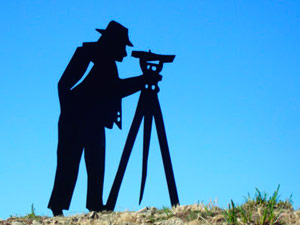
My job was to map the landscape so that the best routes from one place to another could be found and to ensure that land is accurately measured to prevent disputes. I walked the hills and valleys with my chain man, taking readings with my theodolite and mapping the contours. My job was to turn the track between Hobart Town and Launceston into a road capable of accommodating the increasing coach traffic that was generated as the settlers established their farms and businesses from one end of the island to the other.
As you travel the Heritage Highway today you are tracing my work, and also ancient Aboriginal routes that I often followed.
Mapping and naming the land is part of the process of ownership. Surveyors determined sites for settlements, routes for roads and marked out land grants. Their surveyor’s equipment - the theodolite, chain and staff - enabled accurate geometric calculations of the angles of elevation. The surveyor operated the theodolite, a kind of telescope, and the chain-man carried a chain made of links of a particular length that measured the horizontal distance, and held the staff that helped to determine the elevation. This enabled the surveyor to measure the height of hills and contours of the land very accurately and to determine the best route for building roads and bridges.
The theodolite was invented for the Ordnance Survey, Great Britain's national mapping agency established in 1791. The name reflects the original military purpose of the organisation in mapping Britain during the Napoleonic Wars when there was a threat of invasion from France. The Ordnance Survey is widely regarded as the most systematic and thorough mapping institution in the world, detailing every corner of Britain long before satellite technology made quality maps of the same standard available elsewhere in the world.
By the late 1820s, so many newcomers had flocked to Van Diemen’s Land that the main road between Hobart Town and Launceston was crowded with coaches, carts, horsemen and people on foot. In 1827, these passers-by could have paused to watch surveyor William Sharland at work. Dissatisfied with the state of the road, Lieutenant-Governor George Arthur had instructed Sharland to find ways to reduce some of the steep gradients and to shorten the route. Sharland was responsible for the design of St Peter’s Pass, a cutting through the steep hills in the south of the Midlands - no doubt a tough job for the convicts on the road gangs.
Layer 3
William Stanley Sharland (1801–1877)
William Stanley Sharland was appointed to the Legislative Council after Tasmania achieved self-government. Sharland represented New Norfolk in the House of Assembly from 1861 to 1872.
Following his 1827 survey of the main road between Hobart Town and Launceston, Sharland’s recommendation to create what is now called St Peter’s Pass was immediately put into effect. However, his other suggestions such as bypassing Epping Forest sparked lengthy debate and were never carried out.
Like many of the colonial surveyors, Sharland was one of Van Diemen’s Land’s early explorers, and was credited with having ‘discovered’ Lake St. Clair. In 1832, he explored the areas around the sources of the Derwent, Gordon, and King Rivers, a trip that took him to the far reaches of the island’s ‘wild west’ coast.
Sharland’s successful career as a surveyor began shortly after his migration to Van Diemen’s Land in 1823. As well as for his contribution to surveying the road between Hobart Town and Launceston, he is remembered for his involvement in planning the layout of towns including Oatlands, New Norfolk, and Bothwell.
The year after Van Diemen’s Land became Tasmania with the granting of self-government in 1856, Sharland entered politics, initially as a member of the Legislative Council and then as the representative for New Norfolk in the House of Assembly for eleven years from 1861. He was a substantial landholder at New Norfolk with interests in sheep and hop growing.
Sharland died in Hobart Town at his residence in Davey Street on 23 October 1877 aged in his late seventies. He was remembered as being ‘naturally of a very quiet and unobtrusive disposition’. His obituary recorded that Sharland ‘lived a long and busy life, and has passed away amid the mournings of a very large circle of friends and the general regret of the poor, to whom for half a century he was a considerate friend’.
The Tasmanian Tiger, North of Stonor turn-off
Not to blame!
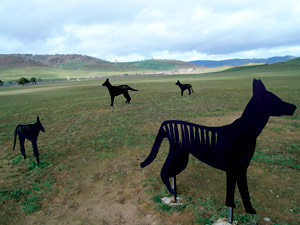
In colonial times, Van Diemen’s Land was the last stronghold of an animal known as a wolf, hyena, Tasmanian tiger or thylacine. Long since vanished from the mainland where only rock art drawings of it remain, the thylacine was hunted to the brink of extinction in Tasmania during the nineteenth century. It was blamed for the deaths of many sheep and lambs, but the real culprits were often wild dogs and hungry convict shepherds.
The thylacine – a distinctive striped animal with a long tail and pronounced snout – vanished from the mainland a long time ago – around the time that the dingo arrived in Australia some 3,500 years ago. The more agile dingo competed with the thylacine for food and eventually the dingo-free island of Tasmania became the thylacines’ last haven.
The Europeans who came to Van Diemen’s Land [Tasmania] at the start of the nineteenth century came with dogs. Once again thylacine numbers began to drop dramatically as the slower creature was no match for the canine competitor.
As settlers began to clear more and more land for farming and grazing, the open forests preferred by thylacines started to vanish. The grassy plains that were once the habitat of these unusual animals were taken over by farms, and towns began to appear.
Thylacines co-existed with Tasmanian Aboriginal people for thousands of years. Europeans, however feared these carnivorous marsupials and through a deliberate policy of extermination brought this unique creature to the brink of extinction.
Thylacines were often blamed for the death of poultry and livestock. They were hunted down increasingly when bounties were offered for their scalps. Such schemes operated between 1830 and 1909, some run by the government and others by local groups. Wild dogs, rather than thylacines, were often the real culprits in the destruction of domestic animals. Shepherds also often falsely accused the thylacine of the slaughter of lambs that they could not account for, when in fact these lambs had provided the poorly paid human watchers with substantial meals.
Ironically, the thylacine finally became ‘totally protected’ under Tasmanian Government legislation on 10 July 1936, just two months before the last thylacine in captivity died at Beaumaris Zoo in Hobart. The thylacine is now presumed to be extinct, although there have been a number of alleged sightings in remote areas of Tasmania over the years. As recently as 1994, an Oatlands’ resident reported startling a large striped animal with a heavy tail in some light bush. He saw it hop a number of times before it took off. When he described the animal to a zoologist, the expert suggested that it might have been a thylacine. Thylacines are known to have occasionally hopped on their hind legs when surprised, before dropping down on all fours and running off.
Despite having vanished for all intents and purposes from the island state, the thylacine continues to be highly visible as an icon. Its image is used to promote a wide range of products and services, from tourism to locally produced beer.
A professional hangman, South of Stonor turn-off
Someone had to do it!
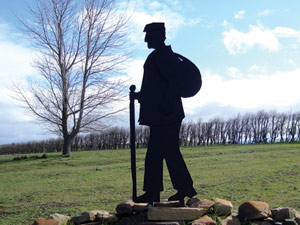
Being the hangman was a reviled and feared profession, but it was essential to the convict system. Those willing to take on the gruesome task could expect rewards for service.
Hangman Solomon Blay took his job seriously, taking care to dispatch his ‘clients’ quickly and efficiently. Hanging was a frightening punishment which was used to control the population.
The threat of the ultimate punishment – being hanged by the neck until dead – was a key part of maintaining law and order in the colony of Van Diemen’s Land. Until the middle of the 1800s hangings were carried out in public and attracted large crowds. Execution was supposed to act as a deterrent. While in Britain hangings were often more like carnivals, in the colonies the crowd would often sing in solidarity with the condemned as they met their end.
In Lieutenant-Governor Arthur’s term of office in Van Diemen’s Land there were two hundred and sixty hangings; of these, one hundred and three occurred in 1826-7 alone. Arthur knew that it was not dying, but the desecration of the body after death, that inspired fear and dread in the popular mind. Bodies were sometimes left in the open for months providing food for carrion-eaters.
Most executions were for crimes against property, in particular theft of livestock as it posed a threat to the colony’s early economy. Such punishment was not only meted out to convicts and bushrangers. Among those hanged for theft of livestock were also free people with their own land holdings.
Solomon Blay was perhaps the colony’s most remembered hangman. Blay held the position for fifty years from 1840, barring a couple of years when he tried to retire. Blay has been described as a murderous man who killed children and was shunned by all. This was far from the truth. It would seem that Blay took pride in his job and was good at it. Where others were described as torturers, Blay had the ability to efficiently dispatch his charges after calmly shaking their hands. In all, he executed 205 people.
The modern expression ‘gala’ is derived from the Anglo-Saxon for ‘gallows day’.
Layer 3: Solomon Blay
Solomon Blay was transported to Van Diemen’s Land for counterfeiting in 1837 when he was 21 years old. Once here, he used his background in boating to gain respect, and by the following year he had been given a position as police constable in Brighton.
He had problems with alcohol which contributed to a stint with a chain gang, from which he unsuccessfully tried to escape. His agreement to become hangman in 1840 afforded him a degree of physical comfort and eventually a regular salary. Blay worked between Hobart, Oatlands and Launceston. He eventually settled in Oatlands from 1846 until 1868. From there he carried out his duties at the gaol and throughout the colony. He endeavoured to change career but despite attempts to settle in Melbourne and in England, Blay and his wife returned in 1870 to what was, by then, Tasmania. Here Blay felt more at home and less persecuted, and he regained his position as executioner in Hobart. Blay finally retired as executioner in 1891. He fell increasingly under the influence of alcohol and died in 1897.
Horse and Rider, Lovely Banks
Convict on Horseback!
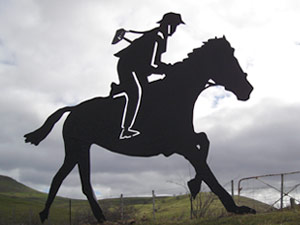
Can you see the rider racing up the highway carrying a mailbag? He is a messenger employed to deliver letters and small packages to the settlers. He could be James White, a stonemason accused of housebreaking and transported as punishment in 1831. Convicts weren’t locked in prisons very much in the early days of the colony. They were the workers who made the colony function. White was entrusted with the job of postal messenger from 1834 to 1836.
In the early days of European settlement, Van Diemen’s Land had no formal mail delivery service. Letters and parcels were delivered by whatever means was available at the time. Until the 1820s there were in fact few horses in the colony due to the long journey from England and the time needed for breeding programs to build up the numbers. Horses imported from Sydney were extremely expensive. The primary form of transport for most people was “shank’s pony” (walking).
With the growing demand for good communication as settlers moved further away from the major population centres, the colony was ready for an official government-operated mail delivery service and, in the 1820s, it had the horses to make it possible. Charges were set by the government and published in the newspapers. The cost of sending a letter between Hobart and Launceston was one shilling, a considerable sum. The mail was carried on horseback restricting the size of parcels that could be accepted. Most significantly, the messengers were convicts, so the newspaper notices made it very clear that messengers were strictly forbidden to leave the highway. Therefore, anyone living away from the road needed to arrange a drop-off point at an inn or house along the way.
Convict messengers were assigned to work for the post office as servants. As the post office was a government service, the upkeep of convict messengers and for the post-horses was paid by the Crown.
The quality and treatment of the post-horses was a matter of ongoing concern and debate. The Superintendent of the Convict Establishment thought that the duties required of the post-horses were severe. The regular post-horse, Tommy, was often required to carry too heavy a weight in relation to the distance and the time allowed to cover it. The Civil Engineer John Lee Archer protested about the condition of the animals on their return to the government stables. He claimed that convict messengers failed to give the horses proper care and attention.
On top of this there was mounting concern about the behaviour of the convict messengers. By 1834, convicts messengers were being replaced by ticket-of-leave men. James White was one of the last convicts to hold the position. He had been nominated for the job by Clerk of Council John Montagu who vouched for White on the grounds that he was of ‘extreme good conduct’.
In 1838, Lieutenant Governor Franklin, responding to criticisms about the unreliability of the postal service, phased out convicts messengers and replaced them with private contractors. This created new opportunities for stagecoach operators to expand their increasingly essential businesses.
Layer 3
James White
James White was a stonemason from Surrey in England who was convicted of house breaking and transported from England for life. He arrived in Van Diemen’s Land on the William Glen Anderson in 1831 and three years later was assigned to the post office as a convict messenger. He eventually received a conditional pardon on 1 July 1842.
Policeman with drunk, near melton Mowbray Hotel
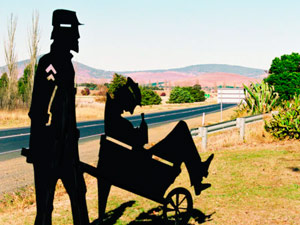
Alcohol was one of the biggest social problems in the colonies of New South Wales and Van Diemen’s Land. It was supplied from government stores according to strict rationing guidelines, which meant that who you were determined the amount you got. Of course there was illegal home-made liquor, and a brew from cider gum that settlers learned about from Aboriginal people. No doubt many wanted to forget the hardships of life in the colony, and that they were such a long way from home with never a chance of returning. As the colony’s police constables often had to work more or less alone, the Government issued wheelbarrows for carting off inebriated offenders to the cells. Here in Melton Mowbray the cells were behind the police cottage, which was near where the hotel is today.
Using wheelbarrows to cart away drunks was an official mode of transportation in New South Wales from 1837 onwards. The Government provided police with this equipment to help them transport intoxicated members of the public. This was not always as straightforward as it might sound. In 1838 the Sydney Gazette reported that a constable carting a drunkard off to the lock-up was in fact intoxicated himself. Rather than wheeling the man to the nearest watchhouse, as was the usual practice, he instead ‘wheeled him over half of Sydney’. The poor fellow was thrown out onto the road on more than one occasion ‘to the mirth of the citizens’ and the gratification of the man’s drunken captor.
As in Sydney, wheelbarrows were used in Launceston, Hobart, and other towns like Melton Mowbray to convey drunks to the cells. Several intriguing stories have survived that provide some insights into this practice.
One story goes that when he was brought before the Supreme Court of Van Diemen’s Land on 24 January 1837, on a charge of having horsewhipped a man in a public street, the defendant Gregson’s character was called into question. Accused of being a drunkard, Gregson was quick to deny that he had ever ‘been wheeled about the streets of Launceston in a wheelbarrow in a beastly state of intoxication’. While Gregson may never have enjoyed such ignominy, his court evidence demonstrates that this practice was in use in Van Diemen’s Land.
Well-known colonial identity and diarist George Boyes, the Colonial Auditor of Van Diemen’s Land, experienced trouble with a string of drunken servants - and it was not only men who were found drunk and wheeled away in the local constabulary’s wheelbarrow! Amongst the incidents recalled in his diary is the following account:
At about 11 o’clock there was a tremendous uproar in the kitchen. A young woman [convict servant] not long in the Colony and only about a month from that wholesale abstergent of vice the “Anson” had become most heroically drunk. Braving all the authorities, the Police in particular, there she was … Screaming, dancing, howling and insulting a poor little constable who had made his appearance with a musket to lead her away. … I was obliged to send for more assistance but it was upwards of two hours before they reached the watch house. They were obliged to lash her in a wheelbarrow and while in transition the whole welkin (heavens/sky) rang with her shrieks and imprecations.
Pulley Kempton Northern Exit, Apsley Railway Line
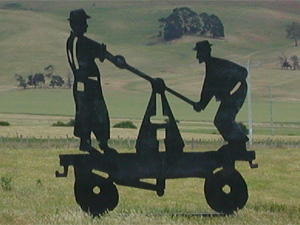
This line was one of a group of lines in the south of Tasmania approved for construction in the early 1880s to complement the then privately owned Main Line. Construction commenced in 1888, and the line was officially opened for traffic by the Tasmanian Government Railway on April 22 1891.
Also known as Green Ponds Line (Kempton). The line started at Brighton station , just on the Hobart side of the Jordan River, before crossing the river on its own bridge (parallel to the then Main Line railway bridge) and then generally following the river to Pontville. Between Pontville and Bagdad, and Kempton and Melton Mowbray, the line ran along a similar alignment to the current highway. From Melton Mowbray to Apsley., the route paralleled the current main roads with the exception of going around the other side of Nannygoat Hilll. Between Bagdad and Kempton, the line winds its way around the hills and next valley to the west of the current highway.
Shepherd, his flock & dog, south of Jericho
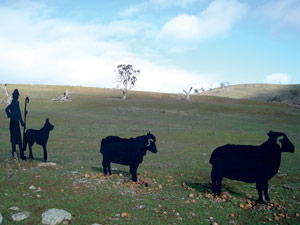
This shepherd was a convict and some of these sheep belong to him. Contrary to the usual image of convicts in chains, in 1817 about half of all the sheep in Van Diemen’s Land were owned by convicts or emancipists and these men and women were able to wander across the open grassy woodlands in comparative freedom. Landowners often gave their convict shepherds some of the new season’s lambs as an incentive to protect the flock from predators and thieves.
Sheep were very important to the early colony of Van Diemen’s Land and continue to be significant today, particularly in the Midlands. The Europeans brought thirty-two sheep to the colony in 1803. Two years later there were more than seven hundred. These were bred for meat rather than wool. Tough breeds and a reasonable climate made sheep profitable for early farmers.
Because there were so few natural predators, sheep were generally allowed to roam free. This avoided the problems of disease usually associated with having to put sheep in yards at night. Instead, a shepherd with his dog might be left in charge of the flock while the landowner himself resided in town.
Convicts were the primary source of labour in the early years of white settlement and this gave them some power. Landowners often agreed to give their assigned convicts one third of the natural increase in the flock they were caring for as an incentive for them to protect the flock from predators and thieves. Conversely, although less often, a ticket of leave man might run sheep on the landowner's property in return for payment of one third of the lambs.
The ‘thirds system’ was eventually outlawed, as it put too many sheep into the hands of the labouring classes. Widespread ownership of stock made it easier to 'launder' sheep, and made almost impossible the task of finding the culprits behind often large-scale sheep stealing operations.
Wool production was not undertaken seriously in Van Diemen’s Land until 1820 when John Macarthur sent merinos from New South Wales to Hobart Town. The one hundred and eighty-one fine wool sheep that survived the journey were sold for seven guineas each, and pioneered the wool industry that became increasingly important to the colony’s economy.
Growing sheep for wool required a more controlled form of husbandry than the somewhat indifferent requirements of the tougher meat varieties. This control and expansion of the industry exacerbated conflicts with Aboriginal people over land use. By the early 1830s Aboriginal peoples had been removed from the grassy woodlands that millennia of their careful use of fire had created, and sheep farmers in Van Diemen’s Land were exporting large quantities of fine wool back to Britain, even outstripping New South Wales. Given the almost ideal conditions created by Aboriginal land management practices, the wool industry prospered well beyond the wildest expectations of the early settlers.
The Stage Coach, Spring Hill
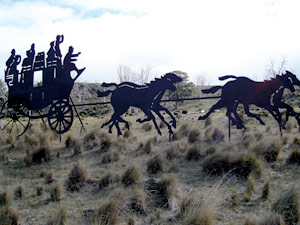
We might like to think of travel in the 1800s as a sedate and dignified affair. In fact, it was fast and furious. Coach stations where horses were changed were built every few miles. People and mail were carried at considerable speed and accidents were not uncommon. There was a lot of money to be made and competition was considerable.
Stage-coaches pulled by teams of horses were the primary mode of public transport in early Tasmania. The ‘stage’ refers to the need to divide the journey up into stages, or sections that one team of horses could undertake before they needed to be rested. This was a distance of about ten miles (16kms). This explains why townships and coach houses were built regularly along the Midlands Highway between Hobart Town and Launceston.
Considerable money could be made operating coaches on the fifteen-hour journey from one end of the island to the other. The most successful operators were John Cox and his wife Mary Ann, and Samuel Page and his wife Grace. Competition was fierce, and the drivers at times became reckless in their quest to be the fastest on the route.
The stagecoach industry contributed significantly to the prosperity of the towns along the Highway especially Oatlands. As well as providing employment for many caterers and accommodation providers, the business kept many grooms, ostlers and stable-hands, harness-makers and blacksmiths occupied. Tradesmen such as saddlers, wheelwrights, coachbuilders and whip-makers also owed much of their business to stagecoach operations. The last coach to travel the Highway did so on 31 October 1876, the year the steam train connected Hobart to the north of the island.
One of the most successful coaching operators was Samuel Page who operated from Oatlands from the 1830s. He had seven coaches and around 150 horses that carried both passengers and the mail; and became a very wealthy man in the process.
Layer 3: Samuel Page (1810 – 1878)
Samuel Page and his wife Grace moved from Hobart to Oatlands in 1837 and ran the Oatlands Hotel. The hotel catered for the many travellers who came through the township on foot, horseback, bullock wagons and in gigs. At the time there were four coach owners vying for trade on the road between Hobart Town and Launceston.
The first coaching service between Hobart and Launceston in 1832 had been owned by John Cox who was the proprietor of Macquarie Hotel in Hobart, the York and the Albany at Oatlands, and the Cornwall at Launceston.
The first trips took three days to cover the 120 miles (193 km) and a fare cost £5. As roads improved, a four-horse stagecoach replaced the tandem team, travelling twice a week and carrying mail under a government contract which was extremely lucrative. When Cox died in 1837 his widow successfully took over the running of the business and within ten years was operating seven daily and four nightly coaches a week from each centre. In 1849 she sold her seven coaches, 150 horses and 24 sets of four-horse harness to Samuel Page. In 1853 Page took over the mail contract. With three coaches daily each way, the service controlled most of the transport on the main road and required 300 horses and three main fodder stations. Fares ranged from 5/- (five shillings), for outside seats, to £5 (five pounds) inside.
During his coaching operations Page acquired many pastoral properties, including Thomas Anstey’s property, Anstey Barton. At one time his landholdings and his flocks comprising 63,000 sheep were said to be the largest ever held by one person in the colony. Page was also an enthusiastic breeder of race-horses and helped to found the Tasmanian Racing Club in Hobart.
He died in Hobart on 31 March 1878.
Stage coach, Kempton northern end
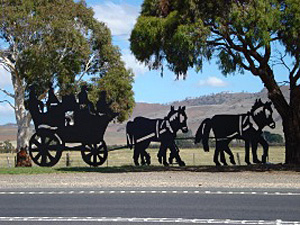
From 1847 onwards, there was extremely fierce competition between the three coaching services operation on the Hobart to Launceston route.
Prices plummeted and drivers often raced each other in a bid to be first at their destination, creating much discomfort and concern for passengers.
By the end of each stage the coach horses would be sweating profusely and quite exhausted. (The horses were changed every hour).
A rub down, rug in a warm stable, together with an occasional quart of hot beer, soon relieved their distress.
Lasting 44 years, it was possibly the most important time in the developing colony. This period saw the establishment of towns along the way, which built up around coach stops.
Coaching lead to the opening of some of Tasmania’s finest grazing and cropping areas, settled by families whose names are still a part of the Midlands heritage today.
Waiting for the coach, Next to The Wilmot Arms
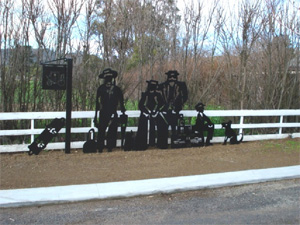
From 1847 onwards, there was extremely fierce competition between the three coaching services operation on the Hobart to Launceston route.
Prices plummeted and drivers often raced each other in a bid to be first at their destination, creating much discomfort and concern for passengers.
By the end of each stage the coach horses would be sweating profusely and quite exhausted. (The horses were changed every hour).
A rub down, rug in a warm stable, together with an occasional quart of hot beer, soon relieved their distress.
Lasting 44 years, it was possibly the most important time in the developing colony. This period saw the establishment of towns along the way, which built up around coach stops.
Coaching lead to the opening of some of Tasmania’s finest grazing and cropping areas, settled by families whose names are still a part of the Midlands heritage today.
Stage Coach, Kempton southern end
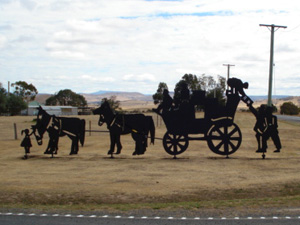
From 1847 onwards, there was extremely fierce competition between the three coaching services operation on the Hobart to Launceston route.
Prices plummeted and drivers often raced each other in a bid to be first at their destination, creating much discomfort and concern for passengers.
By the end of each stage the coach horses would be sweating profusely and quite exhausted. (The horses were changed every hour).
A rub down, rug in a warm stable, together with an occasional quart of hot beer, soon relieved their distress.
Lasting 44 years, it was possibly the most important time in the developing colony. This period saw the establishment of towns along the way, which built up around coach stops.
Coaching lead to the opening of some of Tasmania’s finest grazing and cropping areas, settled by families whose names are still a part of the Midlands heritage today.
Locations
For enquiries please contact
Southern Midlands Council
71 High Street, Oatlands
Tasmania, 7120 Australia
Phone 03 6254 5000
Fax 03 6254 5014
mail@southernmidlands.tas.gov.au



